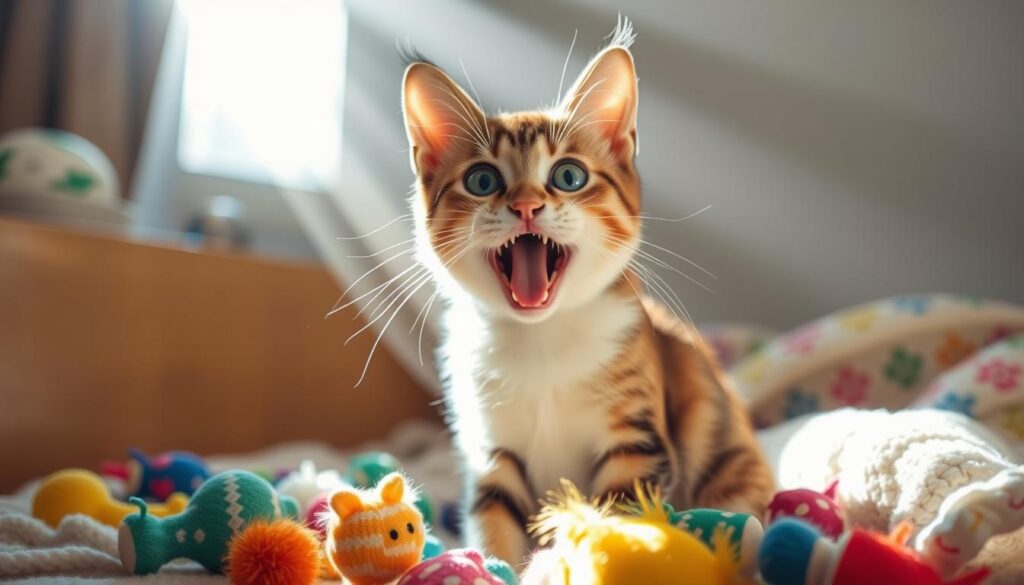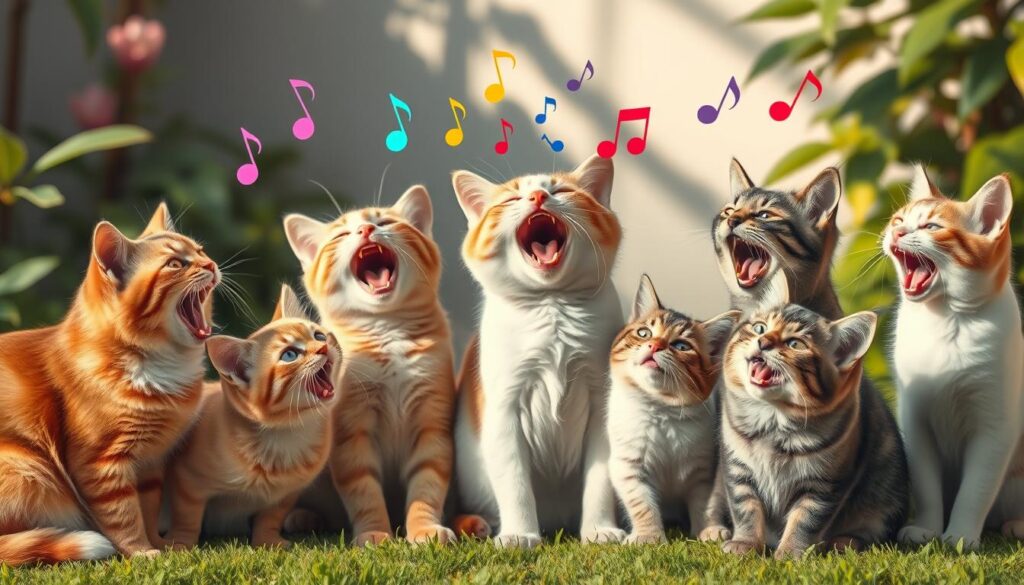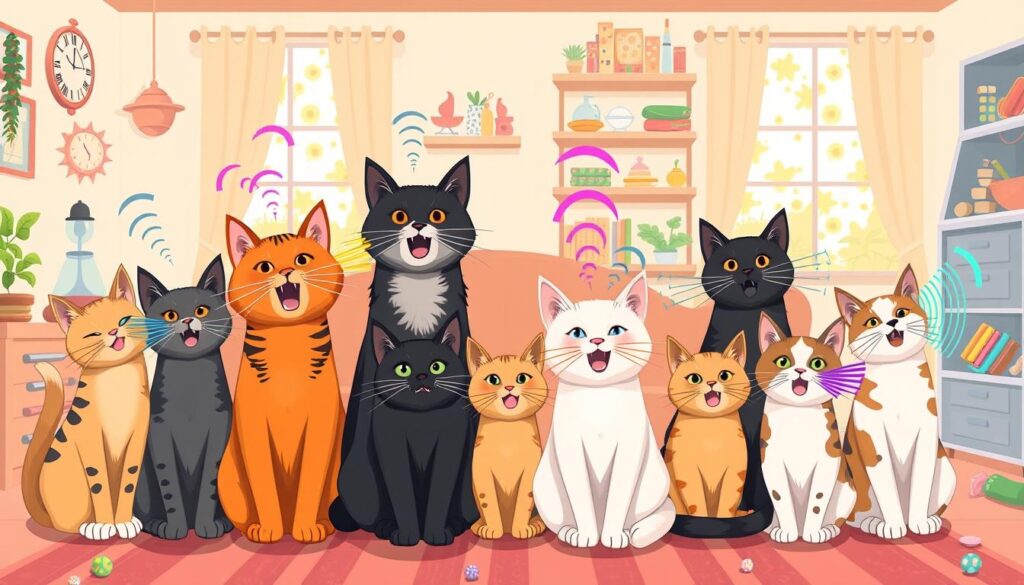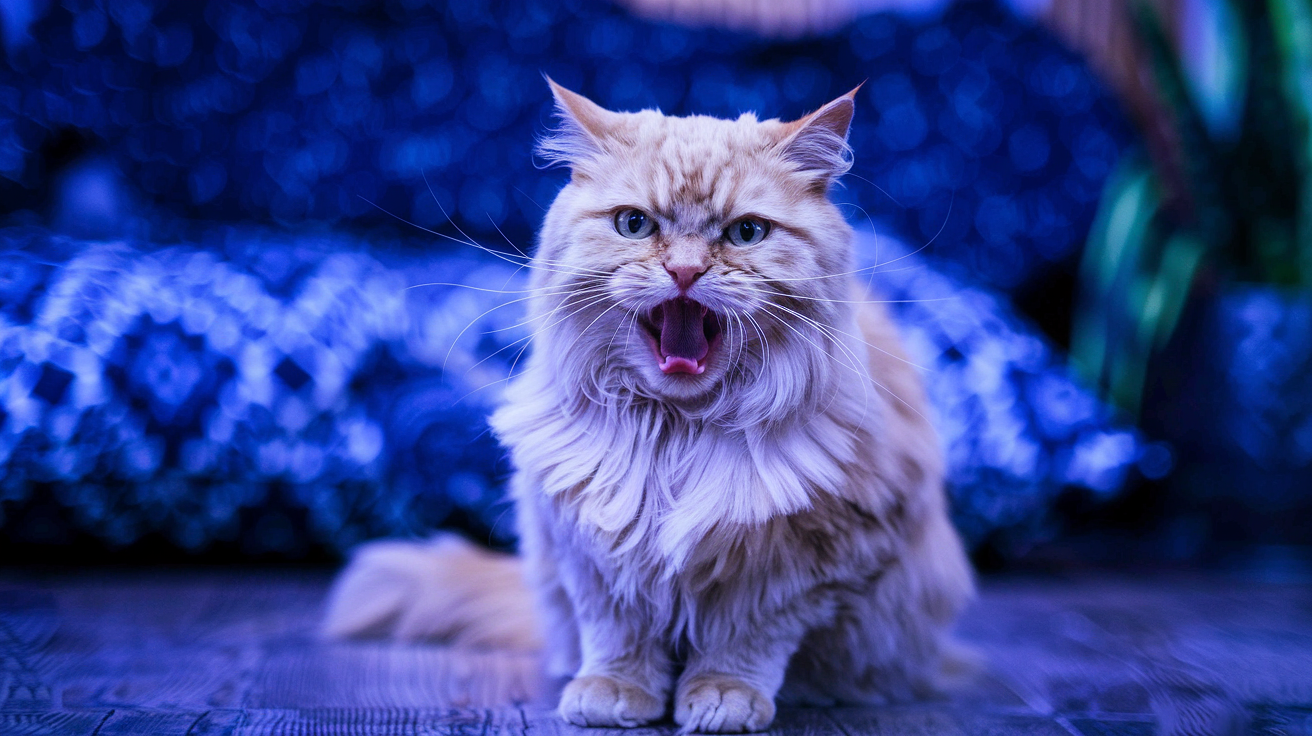Understanding cat meowing patterns is key for good cat communication. Cats use sounds to tell us what they need, want, and feel. It’s important to figure out these sounds to make our bond with them stronger. By knowing how to respond to their meows, we can give them the care they deserve.
Figuring out cat sounds can be tricky. Each cat has its own voice and way of talking.
Learning about cat meowing and communication can really improve our relationship with them. By listening to their different sounds, we can see what they need. Whether it’s food, attention, or just some love, we can meet their needs.
Key Takeaways
- Understanding cat meowing patterns is vital for effective cat communication
- Cats use vocalizations to convey their needs, wants, and emotions
- Recognizing and responding to different meowing patterns can strengthen the bond between cats and humans
- Each cat has a unique voice and way of communicating
- Learning about cat communication can enhance the relationship between cats and their owners
- Pay attention to different sounds and patterns to identify your cat’s needs
The Science Behind Feline Vocalization
Feline vocalization is a complex form of communication that fascinates many. At its core, cat language is a unique system of sounds. Cats use these sounds to convey emotions, needs, and intentions. Understanding this science can help us better appreciate cat language and improve our bond with our feline friends.
Research shows that cats start developing their vocal abilities early. Kittens begin to vocalize as early as two weeks old. As they grow, cats refine their vocal skills, learning to produce a wide range of sounds. This process is closely tied to the development of their brain and nervous system, which enables them to control and modulate their vocalizations.
- Vocal anatomy: Cats have a unique vocal anatomy that allows them to produce a wide range of sounds, including meows, purrs, and hisses.
- Vocal development: Kittens begin to vocalize at an early age and refine their skills as they mature.
- Communication: Feline vocalization is a key component of cat language, allowing cats to convey emotions, needs, and intentions to other cats and humans.
By studying the science behind feline vocalization, we can gain a deeper understanding of cat language. This knowledge can improve our ability to communicate with our feline companions. Whether you’re a seasoned cat owner or just starting to learn about feline behavior, exploring the fascinating world of feline vocalization is sure to be a rewarding experience.
Understanding Cat Meowing Patterns: A Complete Guide
It’s key for cat owners to know how to interpret cat sounds. This helps them understand their pets’ needs and feelings. By learning about understanding cat meowing patterns, you can figure out what your cat wants, like food, attention, or help. This guide will help you better understand your cat’s sounds and improve your bond with them.
Cats use different meows to send messages. A short, sharp meow might mean they want attention. A longer, more sad meow could mean they’re hungry or need help. By noticing these patterns, you can meet your cat’s needs better and grow closer to them.
- A series of short, high-pitched meows, which may indicate excitement or playfulness
- A low, rumbling meow, which may signal contentment or relaxation
- A loud, insistent meow, which may indicate that your cat needs attention or care
By interpreting cat sounds and understanding cat meowing patterns, you can really get to know your cat. This way, you can give them the best care possible.
Cats are highly individualized animals, and their meowing patterns can vary greatly from one cat to another. By paying attention to your cat’s unique vocalizations, you can develop a more personalized understanding of their needs and emotions.
Your Cat’s Vocal Range: From Purrs to Chirps
Cats have their own special way of talking, from soft purrs to loud meows. Learning about cat behavior and decoding cat noises helps you talk better with your cat. Knowing the different sounds your cat makes lets you meet their needs and get closer.
A cat’s voice isn’t just meows. They also purr, chirp, and trill. Each sound shows a different feeling or need. For instance, purring means they’re happy, while chirping shows they’re excited or curious.
- Purrs: a low humming sound that indicates relaxation or self-soothing
- Meows: a vocalization that can indicate hunger, thirst, or attention-seeking
- Chirps: a high-pitched sound that can indicate excitement or curiosity
- Trills: a rolling sound that can indicate happiness or affection
By listening to your cat’s sounds and decoding cat noises, you learn more about their feelings and needs. This helps you meet their needs and grow a stronger bond with your cat.
The Secret Language of Morning Meows
Cat owners often wonder what their cat’s morning meows mean. Understanding cat language helps you meet your pet’s needs better. Morning meows can mean many things, like needing attention, being hungry, or just saying hello.
Knowing the different morning meows can strengthen your bond with your cat. For example, a loud meow meaning “I’m hungry” can be met by feeding your cat at the same time each day. A soft meow might mean “I want attention,” which you can give by spending time with your cat.
- Seeking attention or affection
- Expressing hunger or thirst
- Greeting their human companions
- Signaling a need for exercise or playtime
Understanding your cat’s morning meows can make your relationship better. This can lead to a stronger bond and a happier home for both you and your cat.
Cats use vocalizations to communicate their needs and wants, and by listening to their cat language, we can better understand what they’re trying to tell us.
Hunger Calls and Food-Related Vocalizations
Understanding interpreting cat sounds is key. One common sound is the hunger call. Cats make different noises to show they need food. Knowing these sounds helps you feed them right and keep them healthy.
A cat’s hunger call can sound different. A loud meow means they’re hungry. A softer meow might mean they want attention or comfort. Paying attention to these sounds helps you meet their needs and avoid overfeeding.
To handle food-seeking behavior, set a regular feeding time. Don’t give in to their food demands outside of meal times. This helps your cat eat well and reduces meowing. Understanding and answering their hunger calls strengthens your bond and makes your relationship better.
Here are some tips for handling food-related meows:
- Establish a consistent feeding schedule
- Provide a balanced and nutritious diet
- Avoid overfeeding or giving in to demands for food outside of meal times
- Paying attention to subtle differences in your cat’s vocalizations to respond to their needs effectively
Attention-Seeking Meows and What They Mean
Cat behavior is complex, and understanding the meow meaning is key to a strong bond. Attention-seeking meows need the right response to prevent too much meowing.
Many things can make cats seek attention, like boredom or loneliness. To help, play with your cat or give them interactive toys. Here are ways to handle attention-seeking meows:
- Find out why your cat is meowing: Is it hungry, thirsty, or just wants attention?
- Quickly meet your cat’s needs: If it’s hungry or thirsty, give food or water right away.
- Don’t make too much of it: Don’t give treats or attention when they meow too much. It can make things worse.
Knowing cat behavior and what meow meaning means can help you meet their emotional needs. Stay patient, consistent, and pay attention to your cat’s special needs and personality.

Cats use vocalizations to communicate their needs and wants, and it’s up to us as responsible pet owners to listen and respond accordingly.
Nighttime Vocal Behaviors Explained
It’s important to know why cats meow at night. They might be hungry, bored, or sick. By figuring out why, we can help them sleep better and feel better too.
Some reasons for nighttime meowing include:
- Hunger or thirst
- Boredom or lack of stimulation
- Medical issues, such as pain or discomfort
- Attention-seeking behavior
To stop cats from meowing at night, we can change their food schedule, give them toys, or check their health. Cat communication helps us understand why they meow. By watching their body language and sounds, we can stop them from meowing too much.
Also, making their sleep area calm can help. We can give them a cozy spot, play with them to reduce stress, and have a bedtime routine.
By knowing and fixing the reasons for nighttime meowing, we can make our sleep and our cat’s sleep better. This strengthens our bond through cat communication and understanding cat meowing patterns.
Stress and Anxiety-Related Vocalizations
Cat behavior can change due to stress and anxiety, leading to different sounds. It’s important to understand these sounds to know how they feel. Cats may meow more when they’re stressed or anxious, asking for help or attention.
Things like changes at home, new pets, or loud noises can stress cats out. Finding out why they’re meowing so much is key. By knowing how cats act and what their sounds mean, we can make their environment calmer. This helps lower their stress.
- Excessive meowing or crying
- Changes in vocal tone or pitch
- Increased vocalization at night
Recognizing these signs and acting to reduce stress can make cats feel safer. This strengthens the bond between cat and owner, making their relationship happier and healthier.
Age-Related Changes in Cat Vocalizations
As cats get older, their feline vocalization patterns change a lot. Senior cats may meow differently in terms of frequency, pitch, and how long they meow. These changes come from physical and mental factors.
For example, older cats might hear less and have less control over their vocal cords. This affects their cat language.
Some common changes in cat vocalizations with age include:
- More meowing because of mental decline or getting lost
- Changes in pitch or tone, which might mean there’s a health issue
- Less meowing, which could mean hearing loss or trouble moving
It’s important for cat owners to know about these changes. They need to adjust to their aging pet’s new ways of communicating. By understanding and responding to these changes, owners can get closer to their cat. 
Knowing about age-related changes in feline vocalization and cat language helps owners meet their cat’s special needs. By paying attention to these changes, owners can build a stronger bond with their aging cat. They can also make sure their cat is comfortable and well cared for.
Medical Issues That May Affect Meowing Patterns
As a cat owner, it’s key to know that changes in your cat’s meowing can mean health problems. Understanding cat meowing patterns helps spot health issues early. Some medical conditions can change how a cat meows, affecting its sound, volume, or how often it meows.
Medical issues like hyperthyroidism, cognitive dysfunction, and pain can cause changes in a cat’s meows. Knowing about these health problems helps you care for your cat better.
When to Consult Your Veterinarian
If your cat’s meowing changes, see your vet. They can find out why and tell you what to do next. Look out for these signs of health issues:
- Increased meowing or vocalization
- Changes in the tone or pitch of the meow
- Meowing at unusual times or in unusual contexts
Common Health-Related Vocal Changes
Cats with health problems might meow differently. They might seem more aggressive or anxious. Recognizing these changes and getting vet help ensures your cat gets the care it needs.
Building Better Communication With Your Cat
To improve cat communication, it’s key to look at both sounds and body language. Paying attention to these signs helps you understand your cat better. This can make your bond stronger.
Learning to decode cat noises is important. Cats make different sounds to show how they feel. From happy to stressed, knowing these sounds lets you give your cat the right care.
Creating good vocal habits is also crucial. Spend special time with your cat, like during meals or play. This helps your cat link certain sounds and actions with good things, making your relationship better.
Reading Body Language Alongside Vocalizations
Body language is a big part of cat communication. It’s important to watch your cat’s posture, face, and tail. This way, you can understand their feelings better and react in the right way.
Establishing Vocal Routines
To create good vocal habits, try these tips:
- Make time to talk and play with your cat
- Use treats and praise to encourage good behavior
- Always respond the same way to your cat’s sounds
By doing these things, you can improve communication and grow closer to your cat.
Special Breed-Specific Vocal Characteristics
Different cat breeds have unique ways of making sounds. Some, like Siamese cats, are very chatty. Others, like British Shorthairs, are quieter. The cat language changes a lot based on the cat’s genetics and where it comes from.
Knowing about these special traits can help you talk better with your cat. For example, Siamese cats often “talk” to their owners. They use different sounds to tell them what they need. British Shorthairs, however, are usually quieter and use a softer cat language.

- Siamese and Abyssinian cats are very talkative, using different sounds to communicate with their owners.
- British Shorthairs and Maine Coons are generally quieter, with a softer feline vocalization pattern.
- The vocal traits of a cat can be shaped by its genetics, breeding history, and environment.
By understanding and valuing these special vocal traits, you can strengthen your bond with your cat. Whether you’ve had cats before or are new to cat language, recognizing and responding to your cat’s unique sounds can greatly improve your relationship.
Mastering the Art of Cat Communication: Your Path Forward
Understanding your cat’s complex communication is a journey. By learning about cat vocalizations and body language, you can strengthen your bond. This makes your relationship with your cat more harmonious.
Every cat communicates differently. So, pay close attention to your pet’s unique style. Keep watching your cat’s behavior and note any patterns. Try different ways to talk to them and see what works best.
Learning to understand your cat is rewarding. It makes you appreciate them more. Stay curious and enjoy the journey of building a strong connection with your cat.
FAQ
What are the most common cat meowing patterns and what do they mean?
Cats use different meowing patterns to talk to their humans. Short, high-pitched meows often mean they’re hungry or want attention. Low-pitched meows show they’re happy. Long meows might mean they’re upset or uncomfortable.
Knowing these patterns helps owners meet their cat’s needs better.
Why do cats meow at humans but not other cats?
Cats meow at humans because it’s a way they’ve learned to communicate with us. They use meowing to share their feelings and needs. But, adult cats usually don’t meow at other cats. They use other sounds and body language for that.
What do different types of cat sounds, such as purrs, chirps, and trills, convey?
Cats make many sounds, each with its own meaning. Purring shows they’re happy and relaxed. Chirps and trills often mean they’re excited or saying hello. Knowing these sounds helps owners understand their cat’s emotions better.
Why do some cats meow more at certain times, like in the morning or at night?
Cats might meow more at certain times for different reasons. Morning meows often mean they’re hungry or want to play. Nighttime meows could be because they’re bored, anxious, or need food or play.
Recognizing these patterns helps owners meet their cat’s needs better.
How can I tell if my cat’s meowing is a sign of stress or anxiety?
Stress or anxiety can make cats meow a lot. Look for high-pitched, persistent meows and other stress signs like pacing or hiding. Knowing what causes their stress helps create a calmer home for them.
When should I consult a veterinarian about changes in my cat’s meowing patterns?
Changes in meowing patterns could mean a health issue. Look out for sudden changes in how much they meow, the tone, or if it sounds painful. A vet can check for health problems and help figure out why the meowing changed.
How can I improve my communication with my cat and better understand their vocalizations?
To better communicate with your cat, watch their body language and listen to their sounds. Set regular routines and respond to their needs. By paying attention to both what they say and do, you can understand them better and bond stronger.
Regularly watching and talking to your cat helps you get to know their unique way of communicating.

